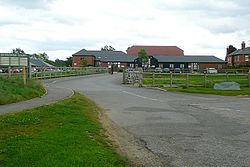Grazeley
| Grazeley | |
| Berkshire | |
|---|---|
 Diddenham Court, Grazeley | |
| Location | |
| Grid reference: | SU698668 |
| Location: | 51°23’45"N, -0°59’45"W |
| Data | |
| Population: | 280 (2001) |
| Post town: | Reading |
| Postcode: | RG7 |
| Dialling code: | 0118 |
| Local Government | |
| Council: | Wokingham West Berkshire |
| Parliamentary constituency: |
Wokingham |
Grazeley is a small village in Berkshire, about four miles south of Reading. To the east lies the village of Spencers Wood; to the west are Grazeley Green and Wokefield and to the south is Beech Hill.
Grazeley is, as it ever has been, divided two parishes; historically these were Sulhamstead Abbots and Shinfield. The part within the ancient parish of Sulhamstead Abbots was a detached part and tything of that parish, which later became a parish in its own right,[1] until swallowed by Wokefield Parish.
Grazeley Green is a hamlet just to the west of Grazeley village. It represents that part of the old parish which became attached to Wokenfield. It has the village pub and a motel.
Both parts of Grazeley were formed into their own ecclesiastical parish in 1860.[2]
History
The name first appears as Grazeley around 1598 and is derived from the Old English Griesley, meaning grazing land (meadow). It has also been known by the names of Greyshall, Greasull, Greyshull, Gresley and Graseley. Around the late 19th century, it was also referred to as Lambwood Hill.
During the 12th century, the Abbot of Reading was Lord of the Manor of Hartley Dummer, which appears to have been around Grazeley. On the dissolution of Reading Abbey in 1541, Henry VIII granted the parish of Sulhamstead Abbots, and Grazeley with it, for purchase by Sir John Williams (later Lord Williams of Thame).
After his death in 1559, Lord Williams' possessions were passed to his daughters. Through various sales and transfers, other major landowners declaring ownership of the area in their title deeds include the Norreyses of Rycote, the Earls of Abingdon, the Jameses of Denford and the Benyons of Englefield.
Holy Trinity Church

Opened in 1850, the 14th century style Church of England parish church of the Holy Trinity was a gift from the Bishop of Oxford. Built in flint and stone, it consists of a chancel, nave, south porch and belfry with a single bell.
Inside the Church an oak tablet on the north wall remembers the local men who lost their lives during the two World Wars, with the inscription:
Ye that live on in English Pastures Green,
Remember us and think what might have been
Holy Trinity held its last service and closed its doors in January 2006 after 156 years of serving the community.
Grazeley Village Memorial Hall

Opened in 1956 the village memorial hall, normally known simply as Grazeley Village Hall, provides a venue for the local community, clubs and societies. The Hall is on Grazeley village green, adjacent to the school and the church. Throughout 2006 it celebrated its golden jubilee with numerous events including a fun run and a summer ball.
Grazeley Court
In 1802, Dr. George Mitford, the flamboyant father of local author Mary Russell Mitford, moved to Grazeley Court Farm for the purpose of "being an English country gentleman with an estate and dignities accruing to the position". His flamboyancy, self-importance and addiction to gambling at cards brought him and his family into debt and unhappiness. Grazeley Court served two purposes for the family – the house was used for the extravagant balls and parties and the outhouses and stables used to establish Dr. Mitford's greyhound kennels. During his time here, George renamed the property 'Bertram House' after an ancestor, Sir Roger Bertram, Baron Mitford, who lived in Northumberland in the 13th century.
William Isaac Palmer, a member of the local biscuit making family (later Huntley & Palmers), lived at Grazeley Court between 1879 – 1895. During his residency he purchased a pedigree Dairy Shorthorn bull for use by local farmers when their cows were in season.
Serving the community
The village has never had a village shop or post office. In the early 20th century, letters were received via Reading with collection boxes outside the church and outside Grazeley Court farm. Money orders could be sent from the nearest office in Three Mile Cross with the nearest Telegraph Office being Spencers Wood.
Villagers would walk reasonable distances, often along the railway line into Reading, or would cycle to Three Mile Cross or Spencers Wood, provided they were home by dusk.
Between the two World Wars, trade vans would visit the village offering meat, fish and bread. Other grocery orders could be placed with the Co-op Bakery man, who would visit from Mortimer Common three times a week. Heating paraffin was also collected from the garage in Three Mile Cross by bicycle.
Modern-day Grazeley
Agriculture was the dominant feature of the village and the surrounding area is still seen in the fields of Grazeley, although there are few farm animals to be seen.
A researcher at the Museum of English Rural Life, case studied Hartley Court Farm in Grazeley as part of a contemporary collecting project during 2003. The studies looked at the activities of local organisations and individuals in the local area, including Grazeley and Shinfield.
On the edge of Grazeley Green and in adjoining Burghfield, factories were built for the Ministry of Defence's Atomic Weapons Research Establishment, which today is responsible for the final assembly, maintenance and decommissioning of the United Kingdom's nuclear deterrent alongside the main AWE site at Aldermaston.
Outside links
| ("Wikimedia Commons" has material about Grazeley) |
References
- ↑ Vision of Britain website
- ↑ Parishes: Sulhamstead Abbots with Grazeley - A History of the County of Berkshire: Volume 3 (Victoria County History)
- Kirkwood, Kerr (1992). Grazeley village 1800–1940: personnified [sic] by its farmers. Reading: Berkshire Local History Association